How to find a wire break in a wall: an overview of methods for detecting and eliminating a break
Due to a violation of the integrity of the wiring, walled up under a layer of finishing materials, apartment residents may be left without the usual amenities.To restore the current supply, you need to know how to find a broken wire in the wall and correct the situation.
We will tell you how and with what tools damage to electrical wiring is detected. We'll show you how to fix any detected problems. You will learn what needs to be done to prevent such problems.
The content of the article:
- Signs of a cable break
- Causes of malfunctions
- Instructions for finding the break point
- Troubleshooting lighting wiring
- Finding the exact location
- Searching for electrical wiring for preventive purposes
- Elimination of broken phase and neutral wires
- Laying open electrical networks
- Conclusions and useful video on the topic
Signs of a cable break
Damage to electrical networks can be suspected if the electrical current supply partially disappears. A broken wire may be indicated by a lack of voltage in outlets located in a certain area, or by lighting not working in a separate room.
Sometimes wiring problems can also be accompanied by smoke or sparking in the cable. The cause of sparking can be not only a break, but also melting of the insulation as a result of illiterate selection of wires and cables.
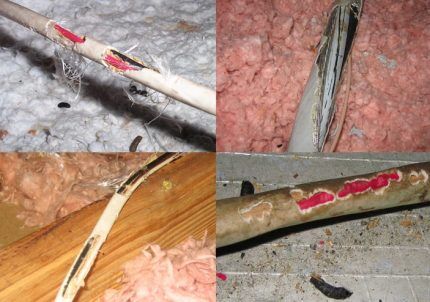
Damage occurs on various sections of the network: the power supply may be disrupted at the point where the cable connects to the socket or switch; in the area between these devices and the box or lighting fixture.
Causes of malfunctions
If the operating rules for electrical communications are observed, they can serve regularly for decades. But in practice, damage to electrical networks is quite common, which can be caused by various reasons.
These factors include:
- Long-term cable operation. Wiring can function flawlessly for many years, but after a certain time limit it begins to deteriorate. In this case, strands scatter in the network and leaks appear, which RCDs are regularly knocked out (its absence affects the increase in leaks). Sooner or later, such violations lead to interruptions, and then to a complete cessation of the power supply.
- Mechanical damage. Without knowing the layout of electrical networks, when drilling holes and driving nails into the wall, you can easily touch a wire, causing it to break and sometimes short circuit. Sometimes minor mechanical damage has a delayed effect: in this case, the integrity of the core may not be damaged immediately, but after several months or even a year.
- Defective wire or poorly executed electrical installation. Damaged cables tend to become constantly hot, which can have fatal consequences. After a sudden power surge, such wires may break.
- Incorrect use of adapters. Electrical wiring malfunctions can be caused by improper use of extension cords or tees.This can happen if several high-power household appliances are connected to the device, for example, a washing machine and dishwasher.
If the adapter is used incorrectly, the cables that come from it are subject to overheating and increased stress, which can lead to melting of the insulation.
In all cases, it is necessary to identify the location of the cable damage in order to immediately repair the damage.
Instructions for finding the break point
If a malfunction is detected, it is necessary to immediately take measures to determine the cause of the damage and search for the approximate location of the electrical network defect.
First of all, you need to check which rooms have problems with the supply of electrical current.

Then you should find out whether the cable break affected lighting fixtures or sockets by checking them with a tester. Depending on the answers to the last question, you should follow the instructions below.
In this case, the malfunction may be caused by a faulty phase or neutral cable.
Broken phase wire
First of all, you need to determine which machine the damaged socket is connected to. Having identified the power source to which the faulty cable is connected, it is necessary to turn off the electricity and disconnect all wires from the panel: “zero”, “phase”, “ground” (if any).
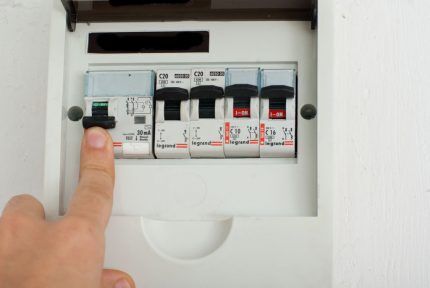
Then you need to arm yourself multimeter, with which you should sequentially check all connections adjacent to the damaged object, starting from the cable in the switchboard.
In this way, you can identify the affected area: usually between two sockets there are two, and in the presence of “ground”, three wires. If in this area it is possible to identify only one vein (for example, a zero), we can safely assume that the break is located here.
Distribution boxes are often inaccessible because they are hidden under a layer of finishing materials. If you have access to such devices, it is advisable to open them, since damage to the cores often occurs in them.
If no malfunctions are found, you should check the non-functioning wires with an indicator, starting with the twists, and also inspect the terminal block and disassembled twists.
A wiring option is possible that does not include junction box installation. In this case, the cables run unhindered from one outlet to another, with two wires entering each outlet box, making up 4 cores. In this case, to identify the defect, it is necessary to remove the devices located at the beginning and end of the faulty section, and then examine all the wires with a multimeter.
Damage to the neutral wire
The search for a broken neutral wire is practically no different from the work on detecting a broken “phase”, but it has certain features.
You can find out about a break in the neutral wire at the contacts of the socket by bringing an indicator screwdriver to this place: it will glow in the “phase”, but will show the absence of a “zero”. In this case, it is useless to use a multimeter to check the voltage, since this device will show an arbitrary value from 0 to 220 V.
It is important to observe strict safety precautions: due to the existing phase, there is still a danger of electric shock even if the socket is not working.
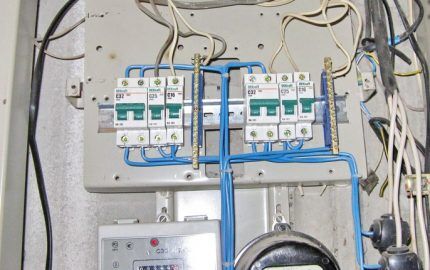
If a three-core cable is used to distribute electricity, a “grounding” conductor can be used as a last resort to transmit “zero”. However, in this case, the “ground” function will be absent from the socket: this is generally undesirable and unacceptable if we are talking about high-power household appliances, for example, a washing machine.
Troubleshooting lighting wiring
If damage occurs between the box and the switch or an artificial light source, you should use an indicator (single-pole voltage indicator) to use it to identify the presence or absence of a “phase”.
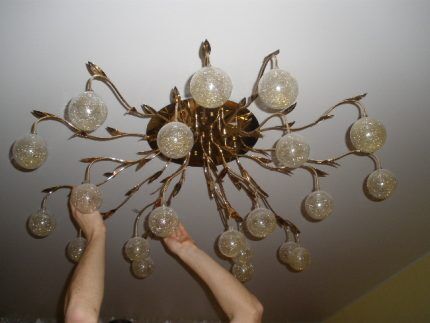
To do this, open the switch from the lighting device; in the off position, the presence of “phase” on the contacts is checked. If it is absent, the break point is between the box and the switch.
If there is a “phase”, its presence is also checked on the lamp (in this case the switch is turned on). If there is no “phase” on all conductors, the place of damage should be looked for between the lamp and the box.
There is an option when, when the lighting is not working and there is no “phase” on the switch, the indicator shows its presence on the lamp.This situation means that the neutral and phase wires have swapped places.
To solve the problem, you need to trace the passage of the “phase” wire along the entire distance of the laid cable, starting from the box to the lamp and then to the switch. It is necessary to find the point where the wires were changed, disconnect them and make new fasteners, positioning the wiring correctly.
If a hidden wiring scanner is used to search for an open circuit, all actions to detect damage will take a couple of minutes:
When searching for damage, you should turn off the power supply to the cable, which can come from any source. In some cases, it may be necessary to burn through the wiring insulation to reduce the resistance level.
Finding the exact location
Having established the approximate affected area, you should begin an in-depth search for the location of the damage, which can be done using different methods. There are various ways to find a damaged wire.
Opening a wall during a major renovation
The easiest way to detect cable damage is to completely clean the walls of finishing materials. In this case, it is easy to inspect the grooves made to accommodate hidden cables. They differ in color from the rest of the surface, and additional putty is applied to them.
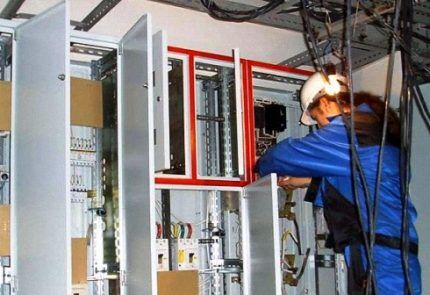
However, since in this case complete exposure of the walls and dismantling of decorative coatings (paint, wallpaper) is required, it is therefore advisable to use it during a major renovation of the room, which involves a new design of vertical surfaces.
Boolean search method
If residents do not have an electrical plan, you can try to recreate it using logic.
Professional electricians are well aware of the basic principles of laying electrical communications, namely:
- Wiring installation is always carried out strictly along vertical and horizontal lines, that is, the cables always run parallel and perpendicular to the floor.
- Power lines located above sockets and switches always run straight up, which is why drilling and hammering nails is strictly prohibited in this area.
- The wiring is usually pulled at a distance of 15 cm from the floor or, more often, the ceiling, so repair work should not be carried out here either.
Knowing the location of sockets and switches, you can create a communications diagram in the apartment.
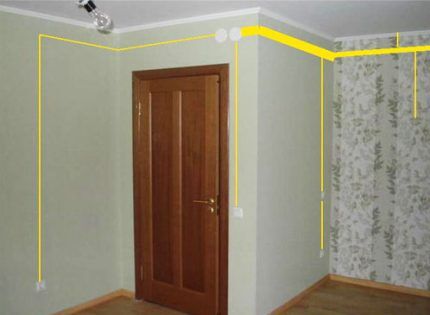
However, to check the proposed layout of electrical networks, it is advisable to use special devices (professional or homemade), which will be discussed below.
Tools at hand: radio and microphone
If necessary, a conventional transistor receiver will allow you to identify the affected area of the cable. It must be tuned to 100 kHz waves and brought to the intended affected area. Above the place where the electrical network passes, the noise of the receiver will intensify, and above the place of the break the crackling will subside.
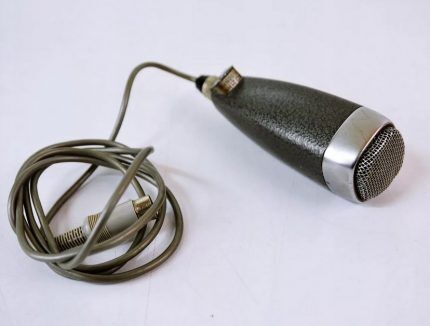
Instead of a radio, you can also use a microphone from a portable tape recorder. It should be plugged into the network and routed above the wall surface where the faulty cable is believed to be located. As in the previous option, a crackling noise will be heard above the power line, which will cease when a break is detected.
It is important to take into account that improvised devices give an error of 10-15 centimeters. In order to avoid electric shock when performing repair work, it is better to play it safe by taking additional precautions.
The following will also help in finding a break in the wiring hidden in the gate:
Search using professional equipment
Special devices - hidden wiring indicators They allow you not only to detect the cable, but also to find the area where the burnt or broken wire is located.
Among the various devices used to locate damage are:
- Alarm E-121 (“Woodpecker”). With its help, you can carry out work at a depth of up to 7 centimeters, which allows you to detect electrical wiring and broken wires even in a wall finished with plasterboard.
- Detector MS. Another popular detector that is easy to use and allows you to get fairly accurate results.
These and similar devices provide quick and reliable results, but have certain disadvantages.First of all, with their help it is impossible to find a cable protected by a foil shield.
Such devices react not only to electrical wiring, but also to other metal objects, for example, nails and screws in the wall. Finally, although these detectors are easy to use, operating them requires attention and skill.
You can also examine the wire in the wall using an indicator screwdriver, but this method is only suitable for cases where live wires are located at a shallow depth in the concrete.
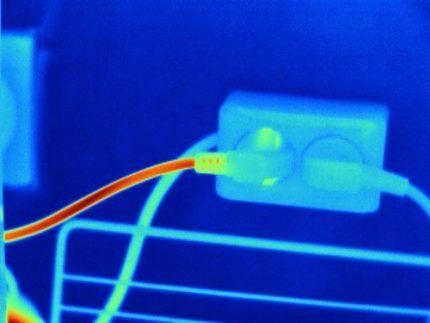
Bosch DMF 10 zoom, VP-440, POSP-1, GVT-92, GVD-504A and others are also suitable for detecting hidden wiring and conductor damage points under plaster. It is possible to use a locator or other professional equipment.
Checking wiring with a homemade device
An alternative to expensive professional equipment can be a budget metal detector made from scrap material.
One of the most popular options is a device made from old CDs. Despite the apparent simplicity of this device, it allows you to find live wiring located under decorative trim at a depth of up to 10 cm.
For the device you will need:
- unnecessary CDs and DVDs (double-sided ones make the device more sensitive);
- battery "Krona";
- calculator (simple model);
- glue;
- insulating tape.
Step-by-step instruction:
- First of all, you need to cut off the headphone plug.Strip the insulation on two wires, exposing the cores by 0.5-1 centimeter.
- The exposed wires should be divided into 2 parts, so that you get 4 cores.
- One of the contacts taken from different groups is attached to each of the disks. On double-sided media they are attached arbitrarily, on single-sided media they are attached to the writing side.
- The installed wires are fixed with glue, and then additionally secured to the disks using electrical tape.
- The remaining two wires are connected in the standard way to the plus/minus of the battery, after which the exposed contacts are carefully insulated with tape.
- The included calculator is also secured to the CD using insulating material.
- A DVD is placed on top of the calculator, then the structure is secured with electrical tape for integrity.
- The battery is attached to the surface of the video disc using electrical tape.
After this, you can test the device, which will produce sound over metal objects.
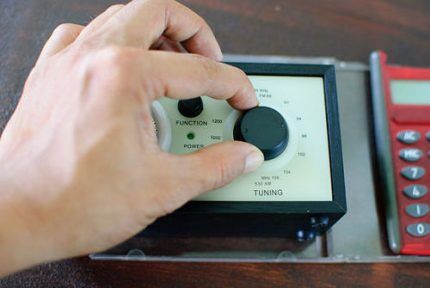
Modern construction technologies often involve the use of beacons or markers in places where electrical networks pass. This greatly simplifies the process of searching for a damaged core using both professional and amateur means.
Searching for electrical wiring for preventive purposes
Usually, electricians or residents start looking for cables running through the apartment when there are problems with the light.
Meanwhile, you should take care of this in other situations:
- Before the planned redevelopment of the apartment. For any manipulations that even affect non-load-bearing structures (for example, when dismantling a partition or moving a doorway), it is important to consider location of electrical communications.
- Before installing sconces, hanging pictures or other wall accessories. To carry out such work, it is important to know where the cable is located so as not to stumble upon it when drilling holes or driving nails.
- When purchasing a home. Immediately after purchasing an apartment, it is advisable to draw up a plan for the electrical networks located along the walls and ceiling. On the diagram it is also worth noting the locations of sockets, switches, and junction boxes. Such markings will help when performing major/cosmetic repairs of the apartment, as well as when arranging furniture.
To search for an electrical route, you can use homemade or professional devices, which were described above.
Elimination of broken phase and neutral wires
Having found out the exact location of the cable break and determined its peculiarity (damage to the “phase”, “zero”), you can begin to repair it.
To eliminate a damaged phase wire, follow these steps:
- First of all, you need to disconnect the phase wire.
- Using a hammer or other tool, remove plaster or other finishing from the wall surface. It is necessary to clear the area along the route by approximately 10-15 cm, covering the area to the right and left of the expected center of damage.
- It is necessary to separate the damaged core from the network, being careful not to touch the insulation on other cables.
- It is better to connect copper wiring by soldering. To do this, you need to take an additional piece of a similar product from which the repair jumper is made.
- It is also advisable to first place a polyvinyl chloride or heat-shrink tube on the core of the damaged cable. The ends of the jumper are twisted with the ends of the broken wire, after which the connections are soldered.
- Insulating tape is applied tightly (in several layers) to the repaired area, after which the tube covered with the wire is carefully pushed onto it. This ensures the tightness of the fastener.
Aluminum wires are less amenable to soldering, which also requires special solder and flux. In this case, the most reliable connection method would be WAGO terminal, in this case, the place of its attachment must be wrapped with electrical tape and additionally covered with sealant.
The wires can also be connected using a junction box. To do this, the insulation is removed from the broken wire, after which its ends are separated in different directions. Using a hammer drill equipped with a special crown, a hole is punched in the wall, the dimensions of which coincide with the parameters of the branch box.
The device is inserted into the opening, after which it is secured with alabaster. The wires are placed in the box, while the damaged wires are connected by color and wrapped with insulating tape. Finally, the box with the restored wires is closed with a lid.
If the cables are placed in special tubes, the damaged wires should be carefully pulled out, and new wires should be inserted in their place using a pulling device.
If the neutral cable is damaged at the beginning of work, it must be disconnected from the bus by attaching the phase conductor. The rest of the process coincides with the regulations described above.
After any type of repair, the grooves are covered with plaster.It is possible to apply voltage to the repaired wiring only after the coating has completely dried.
Laying open electrical networks
Repair work associated with a break in a hidden wiring usually requires complex construction and repair work: dismantling the finish, gating the walls, followed by sealing and covering a section of the wall with decorative materials.
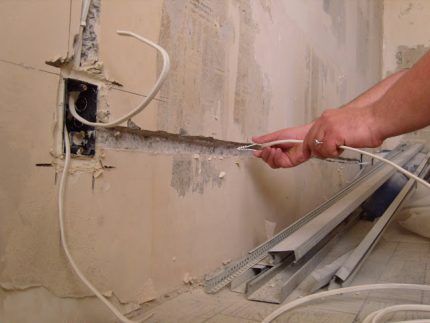
Since immediate implementation of such manipulations is not always possible, in some cases it can be recommended to lay a new wire along the surface of the wall, covering it in a special box or tube.
With a detailed description of the rules and technology laying open electrical network you will find out by reading the article we recommended.
Conclusions and useful video on the topic
The videos below provide detailed video instructions for finding a damaged cable.
Video #1. Searching for a cable break using a metal detector:
Video #2. If you have a radio handy, it can also help:
Finding a broken wire is a rather complex and responsible process. It requires attention, accuracy and strict adherence to instructions. Using the methods outlined above, you can find the location of the wire damage and eliminate the defect found.
Please leave comments in the block below. Your stories about finding an open circuit in an electrical circuit and how to fix it are interesting. Ask questions, share useful information and photos on the topic of the article.




These, excuse me, hemorrhoidal methods of eliminating wiring damage have led to the fact that I simply make new external wiring in boxes. I tried to repair the damage myself after the wiring started to smoke. Apparently, the zero one burned out, because I was shocked so much that I fell off the stepladder. And every time they call electricians and knock out the walls - well, no! Now all the wires are only outside!
Good day, Andrey.
You will have to repair the wiring more than once. Remember the basic rules of PTBE - I have attached a screenshot of the required section. Even after turning off the input circuit breaker of the apartment switchboard, check that there is no voltage.
When laying new electrical wiring, do not skimp on highlighting the lines of hotel rooms and devices. I advise you to provide automatic machines in the apartment panel:
- for a washing machine;
- on the refrigerator, microwave;
- for air conditioning;
- other powerful household appliances.
Also highlight room-by-room socket groups and lighting.
In my house, when I was looking for a broken wire, it turned out that the wire had burned out and carbon deposits had formed there. I did this, took the indicator and led it from the box to the outlet. If the indicator does not show a break along the entire length, this means that the core on which the phase sits is intact, and the break occurs at the zero phase, which means that you need to swap the wires in the box that go to the socket, and then again you need to trace the indicator along the entire length length
Previously, people had to dig into walls to find out where the wire was broken. Now everything is simpler. Control and measuring instruments help us: they accurately identify damaged areas of hidden wiring.You can learn a lot from here. Thank you for your valuable recommendations and more information like this! Having read this particular one, I now know which device I should buy for my household in the future.
But it’s unlikely that you will have such measuring instruments at hand if you are not a professional electrician. Unless you make a homemade device from the material above.
IMHO everyone should have a metal detector (including live wires). The very first “hit” will more than pay for a device in the middle+ price category.